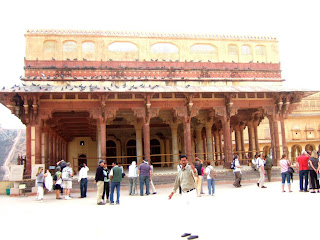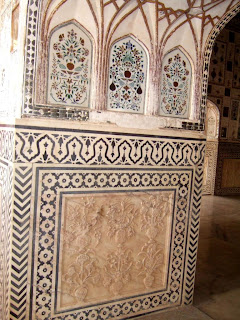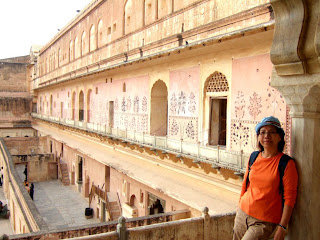
Amber Fort located 11 km away from the city of Jaipur in the Indian State of Rajasthan. It was started building in 1592 by Raja Man Singh I but the project was completed during the reign of Raja Jal Singh I. There were 4 sub-parts in the fort consisting of Ganesh Pol, Jai Mandir, Diwan-I-Aam and Kali Temple. All structures and buildings were made from white marble and red stone but every hall and pavilion has their own specific attraction. Appearance looked rugged and withered from outside but interior designs were marvelous, artistic and outstanding. Amber Fort indicated a glorious history of Kachchawahas Kingdom.



The best and most enjoyable way to ascend the imperial Fort Of Amber was the royal elephant ride. Tourists from all over the world came and queued up in early morning just to have this wonderful experience.



Service of royal elephant rides were only available in the morning between 8.30-11.00 am.



It takes about 30-40 minutes for the ride depending on the speed of elephant's stumping time.


There were hundreds of elephants providing the riding services to Amber Fort and each elephant has a trainer who mostly were quite young in age but with years of experiences.



Our elephant No. 84 was super-active. He overtook all others and kept on curling up his trunk to say hello to every body.


Most tourists like us enjoyed to be traversed on elephant-back going up the steep pathway to the palace complex and squares.




There were little jeeps parking at the corner of steep way ready to bring tourists down the hill.


Flawless beauty of Amber Fort was within your eye sight while riding on elephant up the hill.


The elephants stumped through the arched gateway of Surajpol and entered into Amber Fort's grand square courtyard which is known as Jaleb Chowk. The place is inhabited with shops .



The Surajpol archway.


The white arch structure at the square and some views of opposite side from the hill.



The massive two storey ceremonial gateway, Ganesh Pol was embellished with floral motifs, glass mosaics, frescoes, latticed-stone galleries and with an image of learning and fortune elephant-headed God, Lord Ganesh.



The artistic quality of delicate piece of work in front of Ganesh Pol. Marvelous decoration was influenced by Hindu and Muslin Manner of ornamentation





The arch entrance gate to Kali Temple where photographs were prohibited.



Front courtyard of the Palace Complex is dominated by Ganesh Pol and also Diwan-I-Aam auditorium.


The Diwan-I-Aam auditorium displayed a fantastic carving work with stunning pillars and columns.


Beautiful columns of Baradari near Diwan-I-Aam.


Outside appearance of Jai Mandir looked rugged and withered but interior designs are fine, marvelous, artistic and outstanding.


The grand appearance and royalty of the victory hall, Jai Mandir, exposing the architectural genius of Rajputs and Mughals. Jas Mandir combined the finest elements of Mughal archtecture and Rajput settings in its structure.



Intricate carvings in the wall and ceiling of Jai Mandir Apartments never failed to lures each and every visitor.


The interior was full with decoration with intricately carved Jali screens, delicate mirror, painted and carved dadoes.



All tourist were astonished to eye witnessing the magnificent setting of mirrors and ornamentation work of the interior design with precious stones.





The beautiful roof of Jas Mandir in the upper floor and the pierced screen window which offers a picturesque view of the square



Jas Mandir, located at 4th courtyard, was a hall of private audience.


The floral glass inlays and alabaster relief work of Jas Mandir.


Though many structures were ruined and destroyed but the buildings after 16th century were comparatively stunning.


The hill fortification walls




A scenic picture with steep pathway to Palace Complex viewed from Jas Mandir.



Inside the Palace Complex, there is a Tulsi plant still surviving in the royal residential areas. Tulsi also named as a holy basil had a special significance in the daily life for most Indians.





Tombs of various rulers were in this part of buildings where ceiling and walls were beautifully designed and decorated with colorful gems and precious stones.



The center hall was a gathering place for the queens and females from the royal household.


Dormitories of the 12 queens and the king's room was just at left hand top floor of the queens' dormitories.


All structures were built in a unique artistic style with perfect blend of Hindu and Mughal architecture.



Structures preserved today were mainly built after 16th century as many earlier constructions were either ruined or disappeared..



A panoramic view from the Palace Complex.



Views of Amber Fort from our room window of hotel where we stayed.




The hills became a beautiful background offering marvelous scenery of Amber Fort.


Walk way of Hotel Garden.



The hotel we stayed situated at the most idea place to far view the hills of Amber Fort.



Unknown plant without a single leaf bloomed with huge red and yellow flowers at the entrance of the hotel.







Attractive flowers at Hotel Garden.





The traditional costume of hotel guide and the praying setting at lobby.



(1) Tradition Indian sweet titbits offered at the counter (2) Interesting pair of shoes wore by the guide (3) An artistically design chair at resting place .



The supporting Korean tourists were dancing with locals during an entertainment at our dinner.


One of the art gallery offering the famous paper mate products of North India.





All these paper mach products are originated from Kashmir.


No comments:
Post a Comment